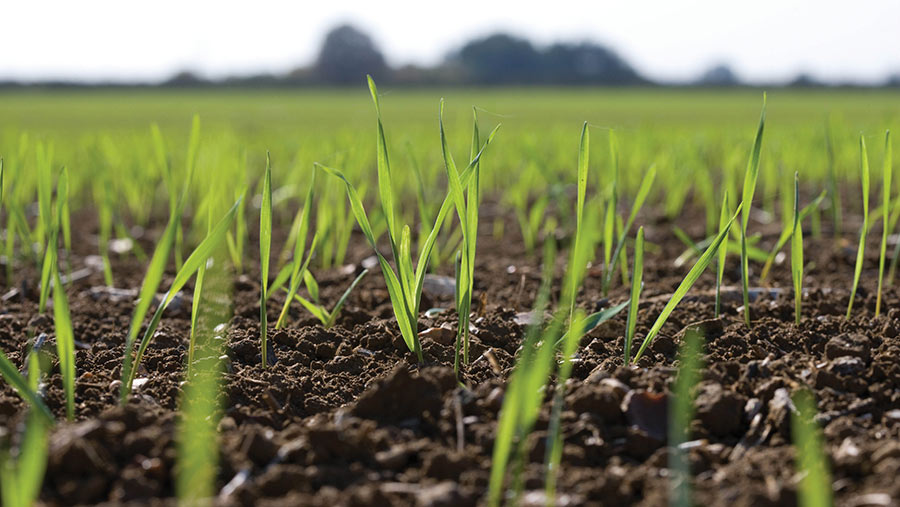How foliar nutrition can kickstart crops and cut costs
 © Tim Scrivener
© Tim Scrivener Foliar fertilisers could be a valuable addition to crop production programmes this season as a means of replenishing leached nutrients and overcoming stunted root systems left over from winter waterlogging.
By directly feeding the plant through its leaves rather than the soil, growers can bypass compromised root structures and kickstart crops into action, while stimulating root development.
Targeted nutrition also holds the key to cutting artificial chemical costs, as healthy crops have the ability to withstand pest and disease attack, which in turn generates high-quality yields.
See also: Crop nutrition focus saves farmer over £43,000 on wheat chemical costs
Nutrition is crucial
“The wet weather will have certainly left soils depleted and lacking in nutrients such as nitrogen, sulphur and boron,” explains independent crop consultant Nick Woodyatt.
Although important to get nitrogen on early, a nutrient-rich foliar spray will wake up plants and get roots growing, so that when nitrogen becomes available, the crops are ready.
Nick recommends a rescue remedy that contains nitrogen in the readily available forms of aminos and amides, alongside a mix of phosphorus, calcium, magnesium, boron, silicon, sulphur and other trace elements to kickstart crops.
“When using foliar nutrition sprays, never apply a nutrient by itself, as they always work together – find the balance. It is also better to spray early in the spring rather than waiting for the plant to be short of something,” he says.
With input costs spiralling upwards and grain prices falling, getting the most from the least is a key goal for many farmers.
Targeted foliar feeds are therefore an effective tool to help improve yields and crop resilience and cut chemical costs.
“It is your farm, your soil, your crops and your future. Only by making sure any profit goes into your account rather than multinational companies will you be able to financially move forward.
“It is vital farmers read all the information out there to make their own decisions,” says Nick.
Improve plant resilience
Sulphur, silicon, calcium and boron are often-overlooked micronutrients critical to the growth and health of crops, with many connections between them.
- Sulphur kickstarts photosynthesis with the formation of chlorophyll and is involved in protein production
- Silicon promotes plant resilience, stimulates defences and strengthens leaf cuticles against pest attack
- Calcium promotes photosynthesis, improves nutrient absorption and plays a key role in disease defence mechanisms, cell strength and structure
- Boron transports sugars into the plant and is involved with seed set, cell structure and nitrogen fixation in legumes
Applying calcium foliar feeds throughout the season can improve yields and keep yellow rust at bay, says biological farmer Tim Parton, who ensures enough boron is present to promote efficacy.
Cereals need about 50g/ha in two to four applications of available boron.
“However, don’t go mad with rates as applying too much can affect availability of manganese, copper and zinc.
“Avoid using ethanolamine-type boron products, as this can become toxic to plants if too much is applied,” he says.
Foliar feeds can be particularly beneficial to use when plant demand exceeds what can be absorbed by roots, or during high nutrient demand such as at grain fill.
This is generally for nitrogen and potassium, or when there is low availability of nutrients caused by shortages of calcium and boron.
Tim says: “Foliar phosphorus is a useful addition to aid plant growth, especially if what is present in the soil is locked up.
“Foliar potassium is also essential to build seed numbers, but remember that this should be balanced with magnesium.”
If using foliar urea, he recommends adding humic acid to aid uptake and enhance nitrogen use efficiency.

© Tim Scrivener
How do foliar feeds enter the leaf?
The way nutrient solutions enter and react with the leaf surface is still in the early days of research, but stomata are believed to play an important role.
Once the spray is applied, it diffuses into the leaf cuticle. In a perfect world the spray would stay as a liquid on the leaf surface for at least 30 minutes.
A thick, waxy leaf cuticle to slow diffusion into the leaf is, therefore, beneficial to maximise uptake and reduce the risk of leaf scorch.
However, fungicide applications often strip away this natural waxy barrier from leaf cuticles, Tim says.
Foliar spray efficacy is determined by:
- The physical and chemical characteristics of the spray tank/nozzles
- Environmental effects based on when the spray is used
- How/where the crop is grown
- Use of additives
- Ability of the spray to penetrate the leaf
- Age of the leaf
- Light levels
- Water availability – drought stops everything, as crops become stressed
- Mobility within the plant
- The phytotoxicity of the chemicals used.
Light levels can affect nutrient uptake, with application timing and weather conditions also important factors.
Applying in the dark can promote absorption and reduce leaf scorch, as the leaf stays wetter for longer and stomata are open at night. Relative humidity and ambient temperature must also be taken into consideration.
It is important to understand the pH levels of your water. Water needs to be clean, otherwise you may get unexpected results and take time to test new spray mixes, especially when considering silicon.
Remember that no spray works the same on all farms. All plants have a range of responses when foliar nutrition is applied and all nutrients have different movement characteristics within the leaf.
For example, calcium and silicon are phloem immobile and, therefore, require more regular spray applications. “This is when experience of your own crops is essential,” says Tim.
Maximise potassium silicate efficacy
Using potassium silicate as a foliar feed is a major step in the right direction to reduce reliance on pesticides, fungicides and plant growth regulators, says biological farmer Tim Parton.
When using the product, he firstly advises adding citric acid granules to water to lower pH.
Then add potassium silicate so it reacts with the water to form potassium citrate and silicon dioxide. After this, the foliar feed products can be added.
However, he highlights the importance of bucket testing and seeking expert advice as you get to know the product.
Adding adjuvants: Citric acid
Plant leaves are naturally hydrophobic, which makes it difficult for droplets to stay on the leaf surface.
Adjuvants can help hold the spray in place by altering the surface tension of water and increasing the leaf surface area in contact with the spray.
Non-ionic mixers are generally used as they do not react with the spray formulation.
“Lately, there has been a huge lift in the use of citric acid granules as an adjuvant as it offers superb results.
“This may be one of the most cost-effective and efficient adjuvants there is,” says farmer Tim Parton.
Getting the correct pH of spray formulation is also important.
“Foliar fertilisers perform best at a pH of 5.5-6, which is why the addition of citric acid granules that naturally lower pH can be beneficial,” he says.
